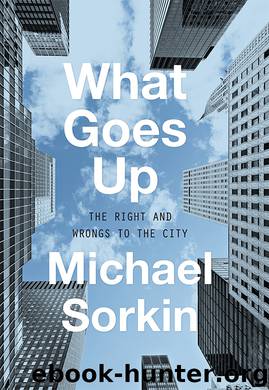What Goes Up by Michael Sorkin

Author:Michael Sorkin
Language: eng
Format: epub
Publisher: Verso Books
29
Back to the Burbs
I grew up in the suburbs and so address this gathering with a combination of expertise and jaundice. In fact my experience was in many ways pleasant, due in large part to the specific character of the suburb in which I was raised. Located in the then-bowery and semi-somnolent climes of Fairfax County, Virginia, the development of my youth—Hollin Hills—was an island of modernity in the rising tide of cookie-cutter split-levels. Designed by Charles Goodman with a landscape plan by Dan Kiley that included extensive community parks and green buffers, the place was almost apparitional in its otherness and, to many in the area, somewhat threatening. Begun in the late ’40s, its frank and glassy modernism attracted a particular breed of buyer, educated and liberal (although one must remember that the model liberal government agency in those days was the CIA, and we had many neighbor spooks).
This sense of exceptionalism—and beleaguerment—gave the place identity and deepened bonds. There arose both a community of interests and a kind of compensatory communalism that did not exactly derive from spatiality but certainly had it as one of its roots. This sense of shared social, political, recreational, and organizational interests was continuous with the idea of modernity—and its communal aroma—expressed in the architecture. There was a “sitter’s pool” for collectivist babysitting, a lively newsletter, a swimming team, collective picnics, amateur theatrics, and organizing for Adlai Stevenson. A feeling of galvanizing otherness was reinforced both by a sense of political isolation in an era when Jim Crow was a local default and by a certain indifference from the organs of local governance. When surrounding roads were running smoothly, snow remained unplowed for days and days in Hollin Hills.
______________________
The brief for the MoMA show and conference at which this chapter was presented took the form of a platonic dialogue.
Of course, it was not. In the early days there was a restrictive covenant on deeds that lasted well into the 1950s, when a house was finally sold to a black neurosurgeon. Later Roberta Flack lived down the street. There were many and refined struggles over the dream at the nexus of the formal and the social. A faction that wanted squash courts in addition to the shared tennis courts and swimming pool was spurned for the elitist vibe of the game. Sidewalks were rejected as a denial of the (new) frontier fantasy. And, the design committee that vetted the numerous additions for compliance with the overall architectural tone was not always a source of harmony. On the other hand, the widespread building of additions—and some houses were multiply expanded—was a sign of literal and conceptual investment in the community, and a dedicated and creative response to the fact that many of the houses started small and to the tractability and flexibility of the type. While I don’t compare this to other self-help paradigms—like the romanticized squatter settlements that so figured in the thinking of my generation—I do feel that the idea of formal, social, and functional malleability is a key to the prospects for the utility of the suburban.
Download
This site does not store any files on its server. We only index and link to content provided by other sites. Please contact the content providers to delete copyright contents if any and email us, we'll remove relevant links or contents immediately.
Kathy Andrews Collection by Kathy Andrews(11730)
The remains of the day by Kazuo Ishiguro(8821)
Paper Towns by Green John(5089)
Spare by Prince Harry The Duke of Sussex(5072)
Industrial Automation from Scratch: A hands-on guide to using sensors, actuators, PLCs, HMIs, and SCADA to automate industrial processes by Olushola Akande(4978)
The Body: A Guide for Occupants by Bill Bryson(4974)
Machine Learning at Scale with H2O by Gregory Keys | David Whiting(4178)
Be in a Treehouse by Pete Nelson(3946)
Never by Ken Follett(3790)
Harry Potter and the Goblet Of Fire by J.K. Rowling(3773)
Goodbye Paradise(3727)
Into Thin Air by Jon Krakauer(3312)
The Remains of the Day by Kazuo Ishiguro(3293)
The Cellar by Natasha Preston(3260)
The Genius of Japanese Carpentry by Azby Brown(3224)
Fairy Tale by Stephen King(3220)
120 Days of Sodom by Marquis de Sade(3179)
The Man Who Died Twice by Richard Osman(2997)
Drawing Shortcuts: Developing Quick Drawing Skills Using Today's Technology by Leggitt Jim(2996)
